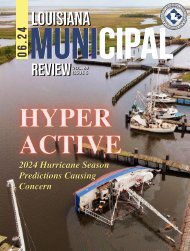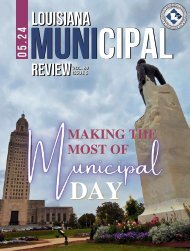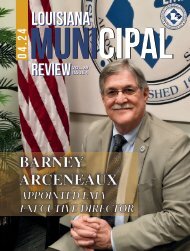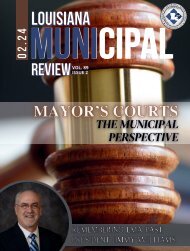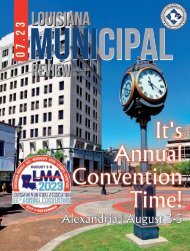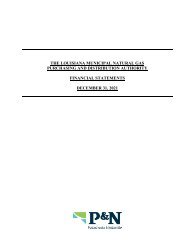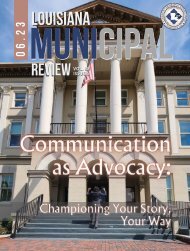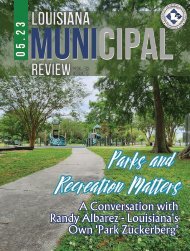October 2023
Create successful ePaper yourself
Turn your PDF publications into a flip-book with our unique Google optimized e-Paper software.
Making Informed Decisions with Data<br />
About ten years ago, our team at the City<br />
of Baton Rouge began hearing terms<br />
we had never heard before – things like<br />
open data, performance management,<br />
data governance, and more.<br />
It isn’t that these were necessarily new<br />
terms. It’s that they were practices that<br />
the private sector primarily used, followed<br />
by larger cities with more resources.<br />
Like so many IT departments in<br />
cities our size and smaller, our Department<br />
of Information Services historically<br />
focused on the traditional IT needs of<br />
our internal customers – networking,<br />
I am sharing all<br />
these details not to<br />
brag or boast, but<br />
to encourage any<br />
municipality seeking to<br />
be more transparent<br />
in their government<br />
operations and use<br />
data to make more<br />
informed decisions<br />
to start down a<br />
similar path.<br />
computer and desktop support, and<br />
application development, among other<br />
functions. But we began learning about<br />
these practices that were new to us involving<br />
leveraging technology in new<br />
and exciting ways – to be a more transparent<br />
government, to drive innovative<br />
thinking in how we structure programs<br />
and services, and to use data more intentionally<br />
to make better decisions.<br />
I will admit that it felt overwhelming to<br />
start. Many larger cities had well-established<br />
data, transparency, and performance<br />
management programs, with a<br />
wealth of resources and infrastructure<br />
to guide their efforts. Not only were<br />
we lacking in the same level of resources,<br />
but we also knew it would involve<br />
a culture shift to help both<br />
our team and other departments<br />
realize the<br />
benefits of working<br />
differently versus<br />
the way we and<br />
they had always<br />
worked. We took<br />
our time studying<br />
other cities and<br />
borrowing best practices,<br />
where we had<br />
the benefit of learning<br />
from both their successes and<br />
challenges. We launched Open Data BR<br />
with ten priority datasets that we knew<br />
would add immediate value to both the<br />
Baton Rouge community and our internal<br />
departments, thereby building confidence<br />
and trust in our work. We built<br />
clear structures and defined processes<br />
for making data more accessible to the<br />
public and other departments without<br />
compromising protected information.<br />
And we engaged the community in this<br />
new approach, holding dozens of presentations<br />
with groups ranging from<br />
homeowner associations and retiree<br />
groups to college classrooms and app<br />
developers.<br />
We also focused on making data available<br />
in multiple formats, such as taking<br />
standard datasets and integrating<br />
them into a map-based platform we call<br />
Open Neighborhood BR, which allows<br />
residents to search and view details on<br />
what goes on around where they live –<br />
from public safety and fire incidents to<br />
new permitting activity. We also continued<br />
investing in our EBRGIS program,<br />
building maps and map-based tools<br />
that brought our data to life in helpful<br />
and engaging ways.<br />
Over the past several years, we have<br />
shifted from a heavy focus on establishing<br />
the structure for transparency<br />
and data-driven collaboration to using<br />
the data to make better decisions. For<br />
example, when our community experienced<br />
several public safety incidents<br />
involving local hotels and motels, we<br />
leveraged location-based data to inform<br />
new ordinances and direct<br />
enforcement plans in areas<br />
where these issues<br />
were most prevalent.<br />
We started using<br />
maps and tablets in<br />
the field to better<br />
coordinate how we<br />
efficiently responded<br />
to potholes or<br />
other complaints in a<br />
given geographic area.<br />
The foundation we set in<br />
Open Data BR enabled other<br />
tools like Open Budget BR, which digitized<br />
our 500+ page budget book into<br />
an easily searchable and viewable public<br />
resource, and Open Checkbook BR,<br />
which integrates with our budget platform<br />
and provides detailed information<br />
on real-time spending across City-Parish<br />
government.<br />
I am sharing all these details not to<br />
brag or boast, but to encourage any<br />
municipality seeking to be more transparent<br />
in their government operations<br />
and use data to make more informed<br />
decisions to start down a similar path.<br />
It takes time to do it right, and as you<br />
can tell, we are ten years down the road<br />
and continuing to build on our successes.<br />
But I will say confidently that it has<br />
absolutely been worth it. Our City-Parish<br />
operates more efficiently, our residents<br />
have greater access to our data<br />
and trust in our work, and other areas<br />
of our community are benefiting from<br />
the brand we are building for Baton<br />
Rouge in being a more digital city.<br />
by Eric<br />
Romero<br />
City of Baton<br />
Rouge/Parish of<br />
East Baton Rouge<br />
Romero is Director of Information Services<br />
with the City of Baton Rouge/Parish of<br />
East Baton Rouge. He can be reached by<br />
emailing eromero@brla.gov.<br />
Page 22<br />
LMR | OCTOBER <strong>2023</strong>




